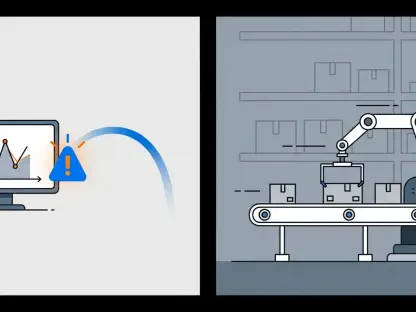The postal and parcel industry faces unprecedented challenges as global e-commerce skyrockets, cross-border shipping expands, and peak periods strain operational capacity to the breaking point. Traditional systems, often bogged down by manual labor and outdated technology, struggle to meet these growing demands, resulting in delays, errors, and escalating costs. Amid this landscape, artificial intelligence (AI) emerges as a transformative force, offering innovative ways to streamline mail recognition, sorting, and delivery processes. One standout solution, Lockheed Martin’s Minerva suite, showcases how proven AI can address these persistent hurdles with precision and reliability. By automating complex tasks and integrating seamlessly into existing workflows, such technology promises not only to enhance efficiency but also to redefine the future of postal operations. This exploration delves into how AI-driven tools are overcoming industry hesitations, driving cost savings, and scaling to meet global needs, ultimately positioning postal services for long-term success.
Overcoming Industry Hesitation with Trusted AI
The reluctance to embrace new technology in the postal sector stems from a deep-rooted fear of operational disruptions that could jeopardize tight schedules and client relationships. Postal operators, working under constant pressure to deliver on time, often view untested innovations as risky gambles that might lead to costly downtime or customer dissatisfaction. This caution has led many to stick with familiar systems, even when those systems fail to keep up with modern demands, creating a cycle of inefficiency that hinders growth and competitiveness in a rapidly changing market.
Fortunately, solutions like the Minerva suite are crafted to alleviate these concerns by offering a proven, low-risk path to modernization. Having been rigorously tested and deployed at an industrial scale, Minerva demonstrates reliability in high-pressure environments, ensuring that businesses can adopt AI without fear of major upheaval. Its ability to integrate smoothly with existing infrastructure, coupled with flexible short-term licensing options, allows operators to experience measurable benefits without committing to permanent changes, thus breaking down barriers to innovation.
Driving Operational Efficiency through Automation
Efficiency lies at the core of successful postal operations, and AI solutions like Minerva are redefining what’s possible in this arena. By leveraging cutting-edge deep learning and advanced image processing, the suite automates labor-intensive tasks such as data entry and video coding, which have long been bottlenecks in traditional systems. This automation not only accelerates the sorting process but also significantly reduces errors, ensuring that higher volumes of mail are processed with greater accuracy, ultimately enhancing service quality for end customers.
Delving deeper into Minerva’s capabilities, specific modules target critical inefficiencies with precision. For instance, the Minerva Enrichment Device (MED) excels at identifying key areas on postal labels, even amidst cluttered or noisy images, while the Minerva Image Processor (MIP) enhances image clarity to boost readability. Together, these tools minimize the need for human intervention, slashing labor costs and increasing throughput. Such advancements enable postal operators to redirect resources toward strategic priorities, rather than repetitive manual tasks, marking a pivotal shift in operational dynamics.
Scaling to Meet Global and Dynamic Demands
The explosion of cross-border e-commerce has introduced new complexities to postal services, from handling diverse label formats to ensuring compliance with customs regulations across different regions. These challenges are compounded by fluctuating mail volumes, especially during peak seasons, which demand flexible and adaptive solutions to maintain smooth operations. AI technology steps in as a vital ally, with tools like Minerva eCommerce (MEC) automating the capture of essential customs data and flagging inconsistencies for further review, thereby streamlining processes and reducing compliance risks.
Beyond specific functionalities, Minerva’s broader adaptability sets it apart in addressing global market needs. Its algorithms can be retrained to recognize emerging patterns or handle sudden surges in demand, making it suitable for operations of varying scales, from local sorting centers to sprawling international hubs. This scalability ensures that postal operators are equipped to tackle the unpredictable nature of modern logistics, maintaining efficiency and reliability regardless of workload or geographic scope, and positioning them to thrive in an increasingly interconnected world.
Demonstrating Real-World Success and Future Horizons
The true value of AI in postal services lies not in theoretical promises but in tangible, real-world outcomes, and Minerva delivers compelling evidence of its impact. Deployments at major operations, such as PostNord in Sweden and facilities in the UK, have yielded significant improvements in read rates and a sharp reduction in manual tasks, proving that this technology can transform day-to-day operations under real conditions. Such results build confidence among operators, showing that AI can be a dependable partner rather than an experimental risk.
Looking ahead, the potential of tools like Minerva Auto Keyer (MAK) to address complex challenges, such as intricate address matching, further underscores AI’s role in shaping the industry’s future. By automating edge cases that typically require human input, MAK eliminates the need for seasonal labor and costly manual data suites, ensuring faster and more accurate processing. As postal services continue to navigate evolving demands, adopting such proven AI solutions offers a clear path to staying competitive, with the promise of even greater innovations on the horizon to enhance global connectivity and efficiency.
Paving the Way for a Modernized Postal Landscape
Reflecting on the journey of AI integration, it’s evident that solutions like Minerva have already reshaped critical aspects of postal operations, from slashing inefficiencies to proving their worth in high-stakes settings. The tangible successes witnessed in diverse implementations highlight a turning point where technology overcame skepticism, delivering measurable gains in speed, accuracy, and cost management. For postal operators looking to build on this momentum, the next steps involve exploring how modular AI tools can be tailored to specific pain points, ensuring targeted improvements without overhauling entire systems. Additionally, fostering collaboration between technology providers and industry stakeholders will be key to unlocking further innovations, addressing emerging challenges, and refining scalability. By prioritizing strategic adoption and continuous adaptation, the postal sector can solidify its foundation for a future where automation and human ingenuity work hand in hand to meet global demands with unparalleled precision.









